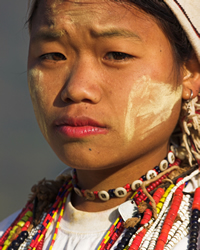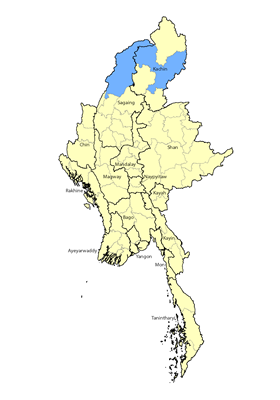The Dunghi tribe, who are also known as the Dongi or Jongi, are a group that speaks its own language. Although historically and culturally they are related to the Naga people, past grievances and discontent led to a cluster of leaders petitioning the Myanmar government to officially recognize them as a distinct ethnicity, which was approved in 1983. Needing a new collective name, these dozens of small tribes and dialect groups created the name Tangshang by combining parts of the names of two famous chiefs, Tangnyu Vang (Tang) and Shangnyu Vang (Shang). During the British colonial era, all Tangshang in Myanmar were considered Nagas.
Location: Numbering an estimated 1,700 people, the Dunghi are an anomaly among the several dozen tribes in Myanmar in that they are now a predominantly Buddhist group, and most of them decided to leave their traditional homeland and relocate to a new state in 2008. At least 80 households of Dunghi people live in the village of Thayatit, near the small town of Shinbwiyan in northern Myanmar's Kachin State. They moved there en masse in 2008 from Nanyun Township in Sagaing Region, where most other people live. Today, only about ten Dunghi families remain in Nanyun. Others live scattered across a wide area, often inhabiting mixed villages with other groups.
Language: The Dunghi speak their own Tibeto-Burman dialect, which is mutually unintelligible with most of the 48 other varieties in Myanmar. Linguistic studies have found, however, that Dunghi shows similarities to eight other dialect groups in Myanmar: the Cyamcyang, Cyolim, Lochang, Lungri, Maitai, Moshang, Mungre, and Shecyu. Each of these groups has been profiled separately in Operation Myanmar. It is hoped that in the future, these tribes will come together and create a common vernacular and written language to benefit the people in their groups, even though there are vocabulary differences among all the dialects.
For many generations the Dunghi people lived in the mountainous Nanyun area of Sagaing, bordering the Indian state of Arunachal Pradesh. The first families to move down to the Shinbwiyan area of neighboring Kachin State are thought to have done so almost a century ago, but in 2008 a group decision was made that resulted in most families moving about 100 miles (162 km) east to Shinbwiyan, which had become a popular place for groups due to its relatively easy access and fertile land. A research team in 2015 found that 53 out of 91 people that they interviewed in Shinbwiyan were born in Nanyun before they relocated.
When the Dunghi decided to start a new life in Thayatit village, they attracted families from five other tribes to join them as they developed their new community. The Dunghi intermarry with people from those groups, and it appears they have few regrets about their move. Wanting to forge a new identity for themselves, most Dunghi in Kachin State have adopted traditional Burmese clothing to help them blend in.
While nearly all other related groups in Sagaing are Christians with a smattering of animists and Buddhists, the Dunghi have included religion as part of their identity transformation. They embraced Buddhism after arriving in their new location, which also qualified them to receive certain government benefits that are not available to Christians. Today, approximately 80 percent of Dunghi people identify as Buddhists, leaving one to wonder how deep their previous Christian faith was, or it was mere nominal Christianity that the people found easy to discard when circumstances changed.
Although about one-tenth of Dunghi people remain Christians today, most of them are among the small number who remained behind in Sagaing. No Scripture or any other Christian resources have ever been produced in the Dunghi dialect.
Scripture Prayers for the Dunghi in Myanmar (Burma).
| Profile Source: Asia Harvest |











